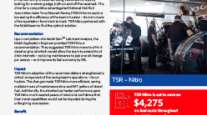Diesel Declines 4.2¢ to $4.088
This story appears in the March. 18 print edition of Transport Topics.
Retail diesel prices declined for the second consecutive week — from $4.13 a gallon to $4.088 — raising hopes that the price might not stay above $4 for long.
Meanwhile, a decadelong study showed which technological strategies are likely to save fleets as much as $5,700 per truck in annual fuel costs, and the U.S. Energy Information Administration said diesel prices are expected to fall during the next two years.
Gasoline also recorded its second consecutive decline — dipping to $3.71 a gallon compared with $3.759 the week before and $3.829 at the comparable time in 2012, EIA said.
The 4.2-cent drop in diesel’s price last week means trucking’s main fuel costs less than it did last year at this time, when it was $4.123 a gallon and still climbing, the EIA said.
Last year, once it hit $4.051 on Feb. 27, the price didn’t retreat below $4 until mid-May. Last week was the first time since November that the price of diesel has been lower than it was a year earlier.
Short term, rising stockpiles and stable oil markets are putting downward pressure on diesel prices at the same time winter demand is easing for the distillate oil that is used to produce both diesel and heating oil, said Phil Flynn, an analyst at the Price Futures Group in Chicago.
“There’s not as much concern because of the calendar as far as the heating fuels are concerned, and the refining margins are pretty darn good; so, there’s an expectation that supply is going to improve, and that should bring prices down [further],” Flynn said.
The closing price for crude oil on the New York Mercantile Exchange March 14 was $93.03, compared with $106.71 at this time last year.
Long term, U.S. oil production is booming and natural gas is becoming a major option in transportation, Flynn said, and both factors are starting to affect diesel prices.
Indeed, while the retail price of diesel was on average $3.97 a gallon in 2012, that average is expected to drop to $3.90 in 2013 and to $3.80 in 2014, EIA said in its March 12 short-term oil price report.
“U.S. crude oil production exceeded an average level of 7 million barrels per day in November and December 2012, the highest volume since December 1992,” the EIA report said.
Trucking’s decade-long search for technological strategies that reduce fuel use and costs also is paying off, according to the latest update of a study unveiled last week at the annual meeting of the American Trucking Associations’ Technology & Maintenance Council.
The updated study of 10 large heavy-truck fleets deploying fuel-efficiency technologies said the carriers annually saved on average roughly $5,700 per truck in fuel costs, a $1,300 savings improvement over the prior year.
The study — by the nonprofit North American Council for Freight Efficiency — is proving what works, said Kirk Altrichter, vice president of maintenance for Gordon Trucking Inc., Pacific, Wash., a study participant.
“Part of the problem is you never know what works or doesn’t work,” said Altrichter, who is also the new TMC chairman.
“We all only have so much time to evaluate product. For us, it was helpful to understand where everybody else is at, and how quickly items were being adopted. It makes our job a little easier.”
Gordon has employed several fuel-efficiency technologies, including trailer side skirts, automatic tire-inflation systems, low rolling-resistance tires, aero-efficient trucks and minimized fuel tanks, Altrichter said.
The top five fastest to be adopted fuel-efficiency technologies included trailer skirts, idling shutdown, tractor chassis skirts, low rolling-resistance duals and gear-down protection, NACFE said.
The study found the average purchased adoption rate of fuel-efficiency technologies increased from 31% to 50% over the period of 2003 through 2012, and the average fuel-economy performance of their trucks improved 0.53 miles per gallon against “business as usual” predictions for emissions technologies and very limited adoption.
The study highlights high-efficiency technologies, said Michael Roeth, NACFE’s executive director.
“Our goal is to accelerate the things that are working and get out of the way of the snake oil and things that aren’t,” Roeth said. “What we find is that — sometimes — the manufacturers oversell the technology, and the government groups are very pessimistic about the technology.”




